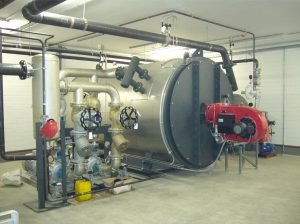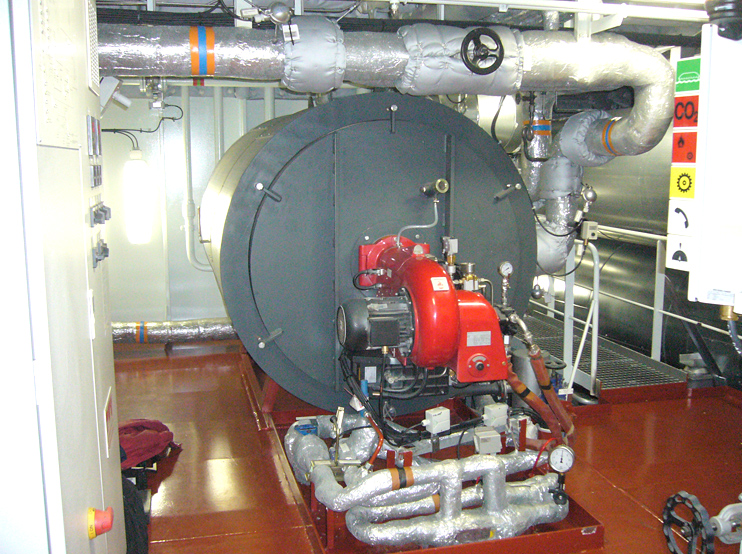UNDERSTANDING, REQUIREMENTS AND FUNCTIONS OF STEAM BOATS ON SHIP
STEAM BOILER
UNDERSTANDING, REQUIREMENTS AND FUNCTIONS OF STEAM BOATS ON SHIP
- Terms of boiler conditions
- The function of the steam produced
- The process of vapor formation
General review :
As a master installation used to drive steam turbines that rotate the propeller, so the ship can move forward and backward.
As a Auxiliary Installation used to drive pumps, especially cargo pumps on tankers, and the most important is to use as a heater.
Steam boiler is a closed vessel that can form steam with a pressure greater than 1 atmosphere, by heating the boiler water in it with hot gases from burning fuel.

A steam boiler must meet the following requirements:
- Within a certain time must be able to produce steam with a certain weight and pressure greater than 1 atmosphere.
- The resulting steam must be with the least possible moisture content
- If further heating is used, then in irregular steam usage, the temperature of the steam should not change much and must be easily regulated
- At the time of motion where the use of steam changes, the steam pressure should not change much
- Steam must be able to be formed with the lowest possible amount of fuel
- The arrangement of the fuel packaging must be such that fuel can be burned without requiring too much cost and energy.
STEAM AND ITS PROPERTIES
- Changes in Energy in the Kettle
In the distribution of combustion engines in general, a steam installation is included as an “external combustion engine” (External Combustion Engine), which is an engine where energy is obtained from the combustion of fuel that occurs outside the engine (steam boiler). So the function of the kettle inside the engine installation outside is a place of burning fuel.
In the kitchen the boiler burns fuel so that it produces heat. The fuel heat is then used to heat the water in the kettle so that it boils and there is steam. In the steam produced by this boiler contained an energy called “potential energy” which later in the steam aircraft will be converted into “mechanical power” either directly on the “piston steam engine” or by means of “kinetic power” in the transmission tube as contained in the “Steam Turbine”.
- Definition of the Steam
Steam Pressure
What is meant by vapor pressure is the force of steam pressing on the walls of a room occupied by each particular unit of area.
Heat and temperature
Heat is a form of effort, while temperature is the degree of heat of an object. Heat can only move from objects that have a high temperature to objects that have a low temperature. So there is heat transfer, because of the temperature difference.
Thermometers are used to measure temperature, but this tool cannot measure the amount of heat. Because the amount of heat depends not only on the temperature, it also depends on the weight and specific gravity of the object.
- Types of Steam, Enthalpi and Heat Formation
There are several kinds of steam conditions. Judging whether the steam still contains water or not, then there are two kinds of steam, namely:
- Wet steam, steam that still contains grains of water.
- Dry steam, steam that does not contain grains of water.
Dry steam can be divided by 2 again, namely:
- Steam is saturated / full
- Steam further heat.
From the description above it can be concluded as follows:
- Satiated steam is the vapor with the highest pressure at a certain temperature
- Wet steam is a mixture of full steam with grains of water, or steam that still contains some percent of water content.
- Further hot steam is steam whose pressure is not proportional to the temperature, or steam whose temperature is higher than the temperature of full steam at the same pressure.
DISTRIBUTION OF Steam Kettles
There are many types of Steam Boilers, and their development can keep up with current technological advances. Of the many types of kettle need to be grouped into several parts. according to its use, construction and others.
Below this grouping will be explained in outline:
- Distribution According to the Steam Law
Because the places of use differ, according to the Steam Act article 9, the Steam Boiler is divided into three namely:
- Permanent Boilers or Land Boilers, namely boilers that are used on land such as factories, power plants and others that have a fixed foundation.
- Boiler Boats, namely boilers used on ships.Here the equipment for the safety of the boilers usually has a slightly different construction from the other boilers, bearing in mind the condition of ships which are always shaking during sailing.
- Boilers that can move.that is, the boilers which are not included in the two categories of boilers mentioned above, such as train boilers, boiler stakes and others.
- Distribution according to its construction
Boilers are made to produce steam by heating the water inside it by hot gas from burning fuel. The kettle must work as efficiently as possible ; meaning that it must be able to produce as much steam as possible with the use of minimal fuel.
Therefore the boiler construction must be such that the heat from the fuel must be absorbed as much as possible by the boiler water to produce steam. To achieve this, the construction of the boiler is made from the arrangement of pipes that separate water and hot gases that heat the water.
Seen from the position of the boiler pipe is divided into:
- Horizontal example: B&W Section
- Vertical example: Foster Wheeler
- Slanted example: B & W Integral
Judging from the substances flowing in the pipe, the kettle is divided into three groups, namely:
- Fire Pipe Kettle.
In this boiler hot gases flow in the pipe, while the heated water is outside the pipe.
For example: – Kettle Schots
– Cochran kettle
- Water Pipe Kettle.
In this boiler that flows in the pipe is boiler water, while the heating gas is outside the pipe. At present, the development of water pipe boilers is more rapid.
For example: – Kettle Babcock and Wilcox
– Foster Wheeler Kettle
– Yarrow kettle
– I S D
– ESD (ESD I, II, III and IV)
3 . Boiler Combined Fire Pipes and Water Pipes.
In this boiler there are two types of pipes, namely fire pipes and water pipes. Its construction is generally like Kettle Schots. And it seems that the making of this kettle is to correct the deficiencies found in the Kettle Schots, such as poor circulation of water in the kettle.
For example: – Kettle Werkspoor
– Howden Kettle – Johnson
- Division according to function
On motorboats the use of steam is of course only for auxiliary aircraft. Whereas for steam ships, the main use of steam is to drive main engines, while other uses are for the support of aircraft. Therefore according to its function on the ship, the kettle is divided into two groups namely:
- Main boiler of the type of water tubes boiler
That is a boiler that produces steam which is used to drive the main engine. At present the boilers that are used as main boilers are generally water pipe boilers, such as:
- Foster Wheeler
o I S D ( Internal Superheat D – type )
o E S D ( External Superheat D – type )
o D S D ( Double Superheat D – type )
o E S R D ( External Superheat Radiant D – type )
- Babcock and Wilcok
o B&W Section
o B & W Integral
o Marine Radiant
- Combustion Engineering
o CEV (Combustion Engineering V – seri)
o CELTG ( Combustion Engineering Law Temp Gas )
o CELTGR ( Comb Eng Law Temp Gas Reheat )
o Kawasaki Superheat Content
o Kawasaki Full Cooled
o Kawasaki Enclosed Membrant.
- Kettle Assist.
Namely a boiler that produces steam, which is used for auxiliary aircraft, such as pumps, heaters and others. The types of boiler that are usually used as auxiliary boilers, for example:
- Mont Exh Gas Economicer
- Cochran Composite Boiler
- B & W M – type
· Foster Wheeler D – type.
KETEL – KETEL HELP:
Large motorboats generally have auxiliary boilers. The benefits of this auxiliary boiler are for heating on ships, such as space heating, kitchens, fuel. and to move auxiliary aircraft.
Kettles of this kind in general, in addition to the lid with fuel oil. usually also combined with utilizing the heat from the exhaust gases coming out of the motor
There are several types of systems or systems, including:
- On a ship there is an auxiliary kettle covered with oil.and a separate kettle with a special exhaust gas for the main motor exhaust.And each of them can form its own steam formation.
2 . La Mont system.
The La Mont boiler is widely used to utilize a portion of the exhaust gas heat from the main motor for the formation of steam. This boiler is usually placed on the exhaust gas road from the main motor or in the chimney, thus it is higher than the main motor (See picture).
The function of this boiler is actually only as a place for the circulation of heat, while the place of formation of the steam is in the other boiler. Thus a circulation pump is needed to drain the water inside the auxiliary boiler (eg Cochran) to the La Mont boiler to finally return to the auxiliary boiler after taking heat. The formation of steam produced by the auxiliary boiler is usually at a pressure of about 7 or the water temperature of the boiler about 170 ° C.
The exhaust gas temperature ranges from 300 – 400 ° C and leaves the La Mont boiler approximately 220 ° C.
The La Mont boiler, which is heated by flue gas, is almost entirely a number of spiral pipes. Each spiral pipe is connected to the intake and exhaust cabinet.
A = Hot tub
B = Boiler water filling pump.
C = Save
D = Boiler water circulation pump (La Mont pump).
E = Spiral pipes that function as ktel water heaters
F, G, H = Cover taps.
At the Harbor: Tap H is open. faucet F and G close.
Pump B road. D stop pump.
At Sea: Tap H closes, tap F and G open.
Pumps B and D both run

